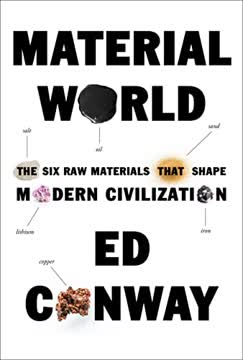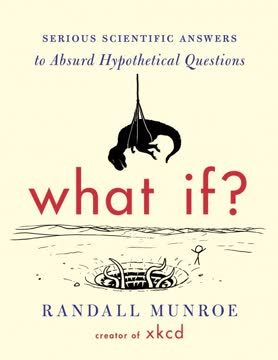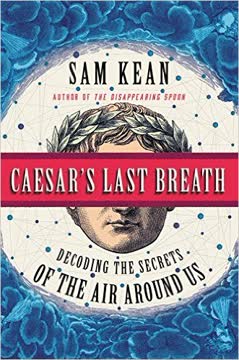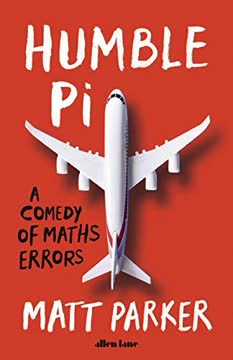Key Takeaways
1. Materials Science: Decoding Our Man-Made World
The material world is not just a display of our technology and culture, it is part of us.
Interwoven with Humanity. Materials are more than just the building blocks of our world; they are deeply intertwined with our civilization, culture, and even our identities. From the Stone Age to the Silicon Age, materials have defined eras, shaped our environments, and influenced our behaviors.
Beyond Functionality. Understanding materials science allows us to decipher the hidden stories behind everyday objects, revealing the desires, innovations, and cultural values that brought them into being. It's about appreciating the intricate engineering and the human ingenuity that transforms raw substances into tools, art, and necessities.
A New Perspective. By exploring the microscopic structures and historical contexts of materials, we gain a deeper appreciation for the complexity and interconnectedness of our world. This perspective encourages us to question our assumptions, challenge our perceptions, and engage with our surroundings in a more meaningful way.
2. Steel: From Ancient Craft to Modern Marvel
It is an odd fact that steel was not understood by science until the twentieth century.
Evolution of Strength. Steel, an alloy of iron and carbon, has been a pivotal material throughout history, evolving from a mysterious craft to a scientifically understood necessity. Its strength and versatility have fueled industrial revolutions and enabled ambitious engineering feats.
Alloying Art. The properties of steel are highly sensitive to the precise amount of carbon and other elements added, a fact that was discovered through centuries of trial and error. This empirical knowledge, passed down through generations of blacksmiths, highlights the importance of both craft and scientific understanding in materials development.
Ubiquitous and Intimate. Steel's presence in our lives is both pervasive and intimate, from the razor blades we use to shave to the cars we drive. Its story is a testament to human ingenuity and our ongoing quest to create stronger, more durable materials that shape our world.
3. Paper: A Ubiquitous Record of Civilization
There is nothing quite like holding a real piece of history in your hand.
More Than Just a Surface. Paper, a seemingly simple material, has played a crucial role in the development of civilization, serving as a medium for communication, record-keeping, and artistic expression. Its versatility and adaptability have made it an indispensable part of our daily lives.
Multisensual Experience. The look, feel, smell, and sound of paper contribute to its unique appeal and cultural significance. From the crispness of a banknote to the scent of an old book, paper engages our senses and evokes memories, creating a powerful connection to the past.
Endangered Species. Despite the rise of digital technologies, paper retains a unique power and authenticity. However, its future is uncertain as electronic alternatives become increasingly prevalent, raising questions about the preservation of our cultural heritage and the sensual qualities of the written word.
4. Concrete: The Indomitable Foundation of Modernity
Reinforced concrete is that material.
The Essence of Modernity. Concrete, a mixture of cement, water, and aggregate, is the most widely used building material in the world, forming the foundation of our cities, infrastructure, and homes. Its versatility, affordability, and strength have enabled ambitious engineering projects and transformed the built environment.
From Ancient Rome to Self-Healing. The history of concrete spans millennia, from the Roman invention of pozzolanic cement to the modern development of self-healing concretes. This ongoing innovation reflects our continuous quest to improve the durability, sustainability, and functionality of this essential material.
Hidden in Plain Sight. Despite its ubiquity, concrete is often overlooked and even reviled for its perceived ugliness. However, its fundamental importance to our civilization cannot be denied, and new technologies are emerging to enhance its aesthetic appeal and environmental performance.
5. Chocolate: A Deliciously Engineered Sensory Experience
For one blissful moment you will be in thrall to the most deliciously engineered material on earth.
More Than Just a Treat. Chocolate is not merely a confection but a carefully engineered material designed to deliver a complex and pleasurable sensory experience. Its unique melting properties, flavor profiles, and textures are the result of centuries of culinary innovation and scientific understanding.
The Art of Crystal Control. The key to chocolate's desirable qualities lies in the precise control of cocoa butter crystals. Tempering, a process of heating and cooling, is essential for creating the perfect snap, gloss, and melt-in-your-mouth sensation.
A Cultural Icon. From its origins as a bitter drink in Mesoamerica to its modern form as a beloved treat, chocolate has played a significant role in human culture, serving as a symbol of luxury, indulgence, and even love. Its enduring appeal is a testament to the power of materials science to enhance our lives.
6. Aerogel: Capturing the Sky in Solid Form
All that remains is to allow the gas to escape, and there is left behind a coherent aerogel of unchanged volume.
Solid Smoke. Aerogel, a lightweight and porous material composed of 99.8% air, is a marvel of materials science, possessing extraordinary properties such as thermal insulation and the ability to capture high-speed particles. Its ethereal appearance and unique characteristics have captivated scientists and engineers alike.
From Jelly to Space. The story of aerogel begins with Samuel Kistler's curiosity about jelly and culminates in its use in NASA's Stardust mission to collect comet dust. This journey highlights the power of scientific inquiry and the unexpected applications of seemingly esoteric materials.
A Material of Wonder. Aerogel's unique combination of properties and its ethereal beauty make it a symbol of human ingenuity and our ability to create materials that defy expectations. Its potential applications in insulation, filtration, and even air purification suggest a bright future for this "solid smoke."
7. Plastics: The Imaginative Material of Transformation
It is the paper that, by concealing and revealing an object, ritualizes the act of giving and receiving, turning that object into a gift.
Endless Possibilities. Plastics, a diverse family of synthetic materials, have revolutionized manufacturing, design, and countless aspects of modern life. Their moldability, durability, and versatility have enabled the creation of countless products, from everyday necessities to high-tech innovations.
From Billiard Balls to the Silver Screen. The history of plastics is a story of innovation, driven by the search for substitutes for scarce natural resources and the desire to create new and improved materials. From celluloid billiard balls to photographic film, plastics have transformed industries and shaped our cultural landscape.
A Double-Edged Sword. Despite their many benefits, plastics have also raised concerns about environmental pollution and sustainability. However, ongoing research into biodegradable and recyclable plastics offers hope for a more sustainable future for this transformative material.
8. Glass: Transparency and the Pursuit of Clarity
When the critical temperature is passed, the liquid has been converted directly into a permanent gas without discontinuity.
More Than Meets the Eye. Glass, a seemingly simple material, has played a crucial role in the development of science, art, and architecture. Its transparency, durability, and ability to be shaped into lenses have enabled groundbreaking discoveries and transformed our understanding of the world.
From Roman Windows to Modern Skyscrapers. The history of glass spans millennia, from the early glassmakers of ancient Rome to the modern architects who create soaring glass skyscrapers. This evolution reflects our ongoing quest for clarity, light, and connection to the world around us.
A Window to the Universe. The invention of the telescope and the microscope, made possible by glass lenses, has revolutionized our understanding of the universe and the microscopic world. These instruments have opened up new frontiers of scientific exploration and transformed our perception of reality.
9. Bone China: The Refined Embodiment of Culture
Stainless steel is the very epitome of our modern age.
A Delicate Balance. Bone china, a type of porcelain made with bone ash, is prized for its strength, translucency, and delicate beauty. Its creation requires a precise balance of materials and skill, reflecting a long tradition of craftsmanship and cultural refinement.
From Chinese Emperors to British Tea Parties. The history of bone china is intertwined with the story of global trade and cultural exchange. From its origins in China to its adoption by European potters, bone china has served as a symbol of wealth, status, and sophisticated taste.
More Than Just a Cup. The act of drinking tea from a bone china cup is a social ritual that embodies values such as elegance, grace, and hospitality. This tradition reflects the enduring power of materials to shape our social interactions and cultural identities.
10. Biomaterials: Rebuilding and Enhancing the Human Body
We may like to think of ourselves as civilized, but that civilization is in large part bestowed by material wealth.
The Future of Medicine. Biomaterials, materials designed to interact with biological systems, are revolutionizing medicine, offering new ways to repair, replace, and enhance the human body. From titanium implants to tissue-engineered organs, these materials are transforming healthcare and extending human potential.
From Plaster Casts to 3D-Printed Organs. The history of biomaterials is a story of continuous innovation, driven by the desire to alleviate suffering and improve human health. From ancient methods of bone setting to the modern development of 3D-printed organs, biomaterials are pushing the boundaries of medical science.
Ethical Considerations. As biomaterials become increasingly sophisticated, they raise profound ethical questions about the nature of humanity, the definition of disability, and the potential for social inequality. These questions require careful consideration as we navigate the future of this transformative technology.
Last updated:
FAQ
1. What’s Stuff Matters by Mark Miodownik about?
- Exploration of everyday materials: Stuff Matters investigates the science, history, and cultural significance of the materials that shape our man-made world, from steel and concrete to chocolate and aerogel.
- Personal and scientific journey: Mark Miodownik blends personal anecdotes, such as his fascination with steel after a stabbing incident, with accessible scientific explanations.
- Materials as cultural forces: The book argues that materials are not just passive objects but active shapers of civilization, identity, and progress.
2. Why should I read Stuff Matters by Mark Miodownik?
- Unique perspective on materials: Miodownik’s expertise and storytelling make complex materials science engaging and relatable, revealing the hidden stories behind everyday objects.
- Bridges science and culture: The book connects scientific concepts with historical, emotional, and cultural contexts, enriching your appreciation of the material world.
- Inspiration for curiosity: Readers are encouraged to see materials as integral to human experience and innovation, not just as background elements of daily life.
3. What are the key takeaways from Stuff Matters by Mark Miodownik?
- Materials shape civilization: The evolution of materials like steel, concrete, and silicon has defined historical eras and enabled technological revolutions.
- Hierarchical structure matters: Materials’ properties arise from their nested structures, from atomic to macroscopic scales, influencing everything from strength to transparency.
- Cultural and emotional connections: Our relationships with materials are deeply personal and cultural, affecting how we perceive and interact with the world.
4. How does Mark Miodownik’s personal experience influence Stuff Matters?
- Origin of obsession: A childhood stabbing incident with a steel razor blade sparked Miodownik’s lifelong fascination with materials and their properties.
- Material awareness: He began noticing the omnipresence of materials like steel in daily life, prompting questions about their unique behaviors.
- Narrative foundation: This personal story serves as a launching point for the book’s blend of memoir and scientific exploration.
5. What are the main materials discussed in Stuff Matters by Mark Miodownik, and why are they important?
- Steel: Examined for its historical impact, crystal structure, and role in tools, weapons, and modern infrastructure.
- Paper: Explored as a medium for communication, culture, and memory, with insights into its manufacturing and preservation.
- Concrete: Detailed as the backbone of architecture, from Roman innovations to modern self-healing concrete.
- Chocolate, aerogel, glass, porcelain, plastics: Each is analyzed for its unique scientific properties and cultural significance.
6. How does Stuff Matters by Mark Miodownik explain the science and significance of steel?
- Crystalline structure and dislocations: Steel’s strength and flexibility come from its atomic arrangement and the movement of defects called dislocations.
- Alloying and carbon content: The balance of iron and carbon determines steel’s properties, with innovations like stainless steel revolutionizing everyday objects.
- Historical evolution: The transition from bronze to steel and the invention of rust-resistant alloys have shaped tools, weapons, and modern life.
7. What insights does Stuff Matters by Mark Miodownik provide about paper and its cultural role?
- Microscopic structure: Paper is a mat of cellulose fibers engineered for strength and smoothness, despite its complex internal makeup.
- Diverse uses: From books and banknotes to receipts and photographs, paper is central to communication and commerce.
- Aging and preservation: The book explains why paper yellows and smells with age, and why old paper holds cultural and historical value.
8. How is concrete portrayed in Stuff Matters by Mark Miodownik, and what makes it fundamental?
- Composite chemistry: Concrete is made from cement, water, and aggregates, forming a strong, waterproof solid through chemical reactions.
- Historical significance: Innovations like reinforced concrete solved brittleness issues, enabling modern architecture and infrastructure.
- Modern challenges: The book discusses vulnerabilities like cracking and corrosion, and new solutions such as self-healing concrete and concrete cloth.
9. How does Stuff Matters by Mark Miodownik explain the difference between diamond and graphite?
- Same element, different structure: Both are pure carbon, but diamond has a cubic crystal structure while graphite has layered hexagonal sheets.
- Bonding and properties: Diamond’s strong, three-dimensional bonds make it extremely hard and sparkly; graphite’s weak interlayer bonds make it soft and conductive.
- Implications for use: These structural differences explain why diamond is used in jewelry and cutting tools, while graphite is used in pencils and as a lubricant.
10. What role does celluloid play in the history of plastics and photography according to Stuff Matters by Mark Miodownik?
- First commercial plastic: Celluloid was the first widely used synthetic plastic, created to imitate expensive natural materials.
- Revolutionized photography: Its flexibility enabled the development of roll film, making photography accessible to the masses and paving the way for motion pictures.
- Cultural impact: Celluloid transformed visual culture and entertainment, becoming foundational in the film industry.
11. What advances in biomaterials and tissue engineering are discussed in Stuff Matters by Mark Miodownik?
- Self-healing materials: Innovations like bioglass and scaffolds support tissue regrowth by providing structures for cells to rebuild bone and cartilage.
- Stem cell integration: The use of adult stem cells on scaffolds has enabled successful lab-grown organ transplants, such as a human windpipe.
- Future potential: Advances in 3D printing and biomaterials could allow for the creation of entire organs, addressing donor shortages and transforming medicine.
12. How does Stuff Matters by Mark Miodownik connect materials to human identity and culture?
- Materials as cultural symbols: Objects like diamonds and porcelain carry meanings of love, status, and sophistication.
- Emotional connections: Everyday materials evoke sensory and emotional responses, influencing rituals and personal identity.
- Dynamic significance: The meanings and uses of materials evolve with technology, design, and collective behavior, reflecting changing human values and needs.
Review Summary
Stuff Matters explores everyday materials through engaging storytelling and scientific explanations. Readers praise Miodownik's ability to make complex topics accessible and fascinating, covering materials like steel, paper, concrete, and chocolate. Many found the book enlightening, changing how they view everyday objects. Some chapters were particularly praised, like those on aerogel and carbon. While a few readers found certain sections weaker, overall the book is highly recommended for its blend of science, history, and personal anecdotes.
Similar Books







Download PDF
Download EPUB
.epub digital book format is ideal for reading ebooks on phones, tablets, and e-readers.




